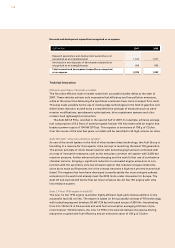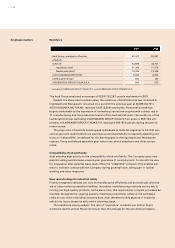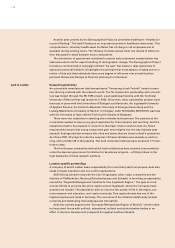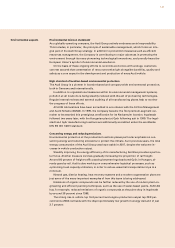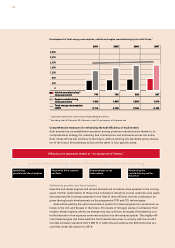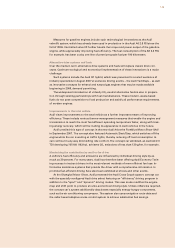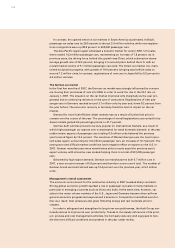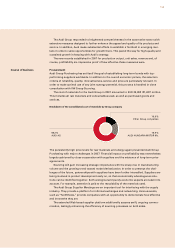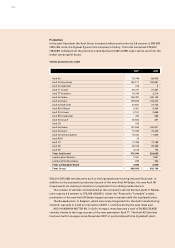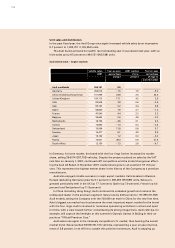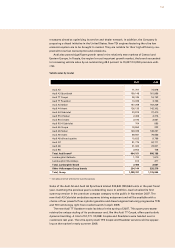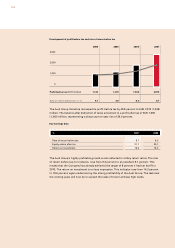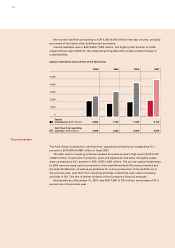Audi 2007 Annual Report Download - page 155
Download and view the complete annual report
Please find page 155 of the 2007 Audi annual report below. You can navigate through the pages in the report by either clicking on the pages listed below, or by using the keyword search tool below to find specific information within the annual report.
152
In contrast, the upward trend on car markets in South America accelerated. In Brazil,
passenger car sales rose by 26.9 percent to almost 2.0 million vehicles, while new registra-
tions in Argentina were up 28.9 percent to 402,000 passenger cars.
The Asia-Pacific region again witnessed a dynamic market for cars in 2007. Unit sales
there totaled 14.3 million passenger cars, representing an increase of 7.8 percent. As in
previous years, the driving force behind this growth was China, which achieved an above-
average growth rate of 22.2 percent, bringing it to second place behind the U.S. with an
overall market volume of 5.1 million passenger cars sold. The Indian car market, too, main-
tained its dynamic progress, with growth of 16.0 percent, bringing total vehicle sales to
around 1.2 million units. In contrast, registrations of new cars in Japan fell by 5.2 percent to
4.4 million vehicles.
The German car market
In the first few months of 2007, the German car market was strongly influenced by consum-
ers moving their purchases of cars into 2006 in order to avoid the rise in the VAT rate on
January 1, 2007. The situation on the car market improved only marginally as the year pro-
gressed due to continuing reticence on the part of consumers. Registrations of new pas-
senger cars in Germany reached around 3.1 million units by year end, down 9.2 percent from
the year before. The economic recovery in Germany therefore had no impact on the car
market.
Demand for more fuel-efficient diesel models rose as a result of further fuel price in-
creases over the course of the year. The percentage of overall registrations accounted for by
diesel models gained 3.4 percentage points, to 47.7 percent.
German-built vehicles proved to be very popular on international markets, as a result of
which high passenger car exports over-compensated for weak domestic demand. In the year
under review, exports of passenger cars totaling 4.3 million units bettered the previous
year’s record figure by 10.6 percent. The countries of Western Europe were the most impor-
tant sales region, accounting for 2.6 million passenger cars, an increase of 10.7 percent. The
strong euro and difficult market conditions had a negative effect on exports to the U.S. in
2007. German manufacturers were nevertheless able to nearly equal the previous year’s
export volume, with attractive new models helping them to a total of 551,000 passenger
cars.
Bolstered by high export demand, German car manufacturers built 5.7 million cars in
2007, a year-on-year increase of 5.8 percent and therefore a new record total. The number of
German-brand cars built abroad was up 10.4 percent over the previous year, at 5.2 million
units.
Management’s overall assessment
The economic environment for the automotive industry in 2007 revealed sharp contrasts.
Strong global economic growth sparked a rise in passenger car sales in many markets, in
particular in emerging countries such as China and India. At the same time, however, car
sales in the major volume markets of the U.S., Japan and Germany became divorced from
general economic progress and experienced a downturn. Competition intensified even fur-
ther as a result. Cost pressures also grew following energy and raw materials price in-
creases.
In order to safeguard and strengthen its long-term competitiveness, the Audi Group con-
tinually strives to improve its own productivity. Thanks to the steady refinement of its prod-
uct, process and cost management activities, the Company was very well equipped to han-
dle the more difficult conditions encountered in the year under review.


